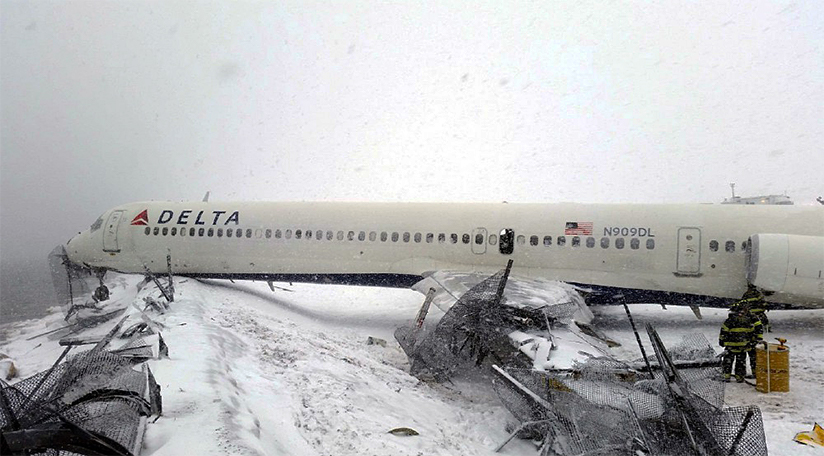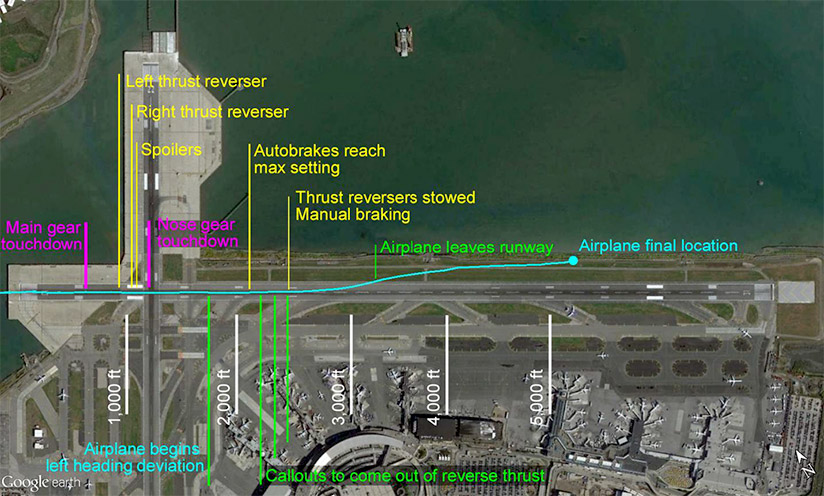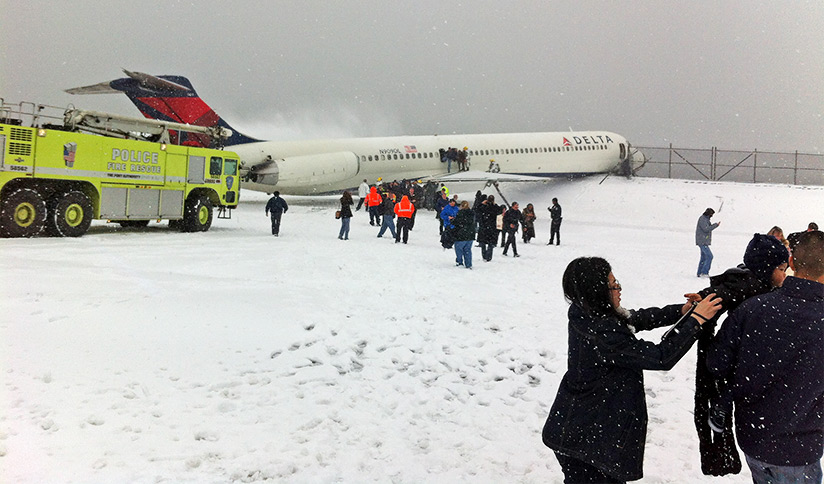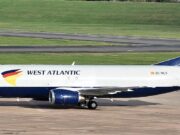
Concerned about the slippery and relatively short runway at New York’s LaGuardia Airport, the flight crew of the Boeing MD-88 decided early that they would attempt to land only if they received a report of good braking action.
Due to lengthy snow-removal operations, the MD-88 was close to the airport before the crew received the green light they were looking for: The pilots of two preceding airplanes had reported good braking action after landing.
The crew proceeded, expecting to see at least some clear portions of runway on approach. But when the MD-88 broke out of the clouds, they saw only white: The runway was still totally covered with snow.
The captain applied reverse thrust shortly after touchdown — but far more than was recommended for a slippery runway, according to the U.S. National Transportation Safety Board (NTSB).
This caused a phenomenon called rudder blanking, in which the smooth airflow over the rudder was disrupted, rendering this critical flight control surface useless when it was needed most.
To make matters worse, the reverse thrust was applied asymmetrically, with more from the left engine than the right, which exacerbated the effects of a right crosswind. These factors caused the airplane to yaw left and begin to slide.
The captain was unable to regain directional control before the MD-88 veered off the runway and came to a stop with its nose atop an embankment adjacent to Flushing Bay. Damage was substantial, and 29 passengers sustained minor injuries. The other 127 passengers, the three flight attendants and the pilots were not hurt.
Based on the findings of its investigation of the accident, the NTSB concluded that the probable cause was “the captain’s inability to maintain directional control of the airplane due to his application of excessive reverse thrust, which degraded the effectiveness of the rudder in controlling the airplane’s heading.”
Contributing factors were “the captain’s situational stress resulting from his concerns about stopping performance and attentional limitations due to the high workload during the landing, which prevented him from immediately recognizing the use of excessive reverse thrust.”
The investigation produced several recommendations, including development of methods to preclude application of excessive reverse thrust and creation of on-board equipment that can measure and transmit real-time information about an airplane’s braking ability on landing.
‘Highly Experienced’
The accident occurred the morning of March 5, 2015. The airplane was being operated by Delta Air Lines as Flight 1086 to New York from Atlanta, Georgia.
“The captain and the first officer were highly experienced MD-88 pilots,” with 11,000 flight hours and 3,000 flight hours, respectively, in type, the NTSB’s report said. “In addition, the captain was previously based at LGA [LaGuardia Airport] and had made many landings there in winter weather conditions.”
The captain, 56, had served as a U.S. Air Force F-16 pilot and instructor before being employed by Delta in 1989 as a Boeing 727 flight engineer. He held type ratings for the DC-9 series, 757 and 767. He had 15,200 flight hours, including 9,700 as pilot-in-command of MD-88s and 90s.
The first officer, 46, had served as a U.S. Navy E2C Hawkeye pilot and as a 727 flight engineer with another airline before joining Delta in 2007. He had about 11,000 flight hours and held a type rating for the DC-9 series.
The pilots were on the second day of a four-day trip sequence. They had reported for duty at 0500 local time in Daytona Beach, Florida, and had flown the MD-88 to Atlanta, arriving at 0705.
The airplane, delivered new to Delta in 1987, had accumulated 71,196 flight hours and 54,865 cycles. “The electronic airplane data logs showed no open items related to the flight controls, engines, landing gear or brakes,” the report said.
Major Snowstorm
The northeastern United States was under the influence of a major winter storm the day of the accident, and significant accumulations of snow were expected in the New York area.
Snow had begun falling at LaGuardia early that morning, and an accumulation of 4 to 7 in (10 to 18 cm) was expected by the time the airplane arrived there. The terminal forecast called for surface winds from 330 degrees at 12 kt, 1/2 mi (800 m) visibility in moderate snow and mist, and a broken ceiling at 700 ft.
The airplane departed from Atlanta at 0924, after a 45-minute delay to repair the captain’s oxygen mask. Estimated time en route to New York was 1.5 hours.
“During the flight, the pilots continued to monitor the weather conditions at LGA,” the report said. They were especially concerned about the runway conditions and spent considerable time analyzing expected landing performance on the contaminated runway.
Automatic terminal information service (ATIS) broadcasts indicated that Runway 13 was in use for landings. Consulting Delta operations data, the pilots determined that the MD-88’s landing performance would be sufficient only if the 7,003-ft (2,135-m) runway had good braking action.
“If it’s less than good, we’re not landing,” the captain said.
“Roger that,” the first officer replied. “I don’t blame you one bit.”
‘Situational Stress’
With good braking action, reverse thrust and maximum autobraking, the calculated landing distance, including a 15 percent safety margin, was 6,200 ft (1,890 m) — 803 ft (245 m) less than the available landing distance.
The MD-88 was about 45 minutes from the airport, cruising at 33,000 ft, when the crew asked both the air traffic control (ATC) center controller and the company dispatcher for braking-action reports. However, none were available because the runway was still being cleared of snow, and no airplanes had landed.
“The unavailability of braking-action reports and the uncertainty about the runway’s condition created some situational stress for the captain, who was the pilot flying,” the report said, noting that the captain repeatedly expressed his frustration to the first officer about the lack of timely braking-action reports from ATC and company dispatch.
When the center controller asked the crew if they would be able to conduct the instrument landing system (ILS) approach to Runway 13, the first officer replied, “We can certainly do the ILS to one three, but we need braking action reports. We’re trying to get them from dispatch as well.”
‘Less Than Good’
The MD-88 was about 30 minutes from the airport when snow-removal operations were completed. About 15 minutes later, while descending to 10,000 ft, the crew was monitoring the approach control frequency when they heard the controller advise the pilots of two preceding airplanes — another Delta MD-88 and a Bombardier CRJ700 — that a report of poor braking action had been made by the crew of an airplane that had just been landed on Runway 13.
The crews of both of the preceding airplanes told the controller that they could not land on a runway with poor braking action. Hearing that, the captain of the accident airplane reiterated to the first officer that they could not land with poor braking action either.
Shortly thereafter, the crew of an Airbus A319 reported good braking action after landing on Runway 13. The pilots of the other MD-88 and the CRJ then proceeded to land. The crew of the CRJ700 subsequently reported braking action as good; the crew of the MD-88 did not make, and was not asked to make, a braking action report.
However, in a discussion of the subjective nature of pilot reports of braking action, the accident report noted that investigators later found that braking action likely was somewhat less than good. “Postaccident simulations showed that the braking action at the time that the accident airplane touched down was consistent with medium (or better) braking action,” the report said.1
Nevertheless, although braking action was found to be less than the “good” reported by the crews of the A319 and CRJ, investigators also determined that it was good enough: “Although the runway was contaminated with snow, runway friction when the accident airplane landed was sufficient for stopping on the available runway length,” the report said.
Right Crosswind
At 1052, the approach controller advised all aircraft on his radio frequency that ATIS Quebec was current. It reported winds from 030 degrees at 11 kt, a runway visual range of 6,000 ft (1,800 m) with snow and freezing fog, and an indefinite ceiling at 900 ft.
The approach controller then vectored the MD-88 crew to intercept the Runway 13 ILS final approach course and instructed them to establish radio communication with the tower controller.
The captain told the first officer to “ask one more time for a wind check. I’m showing a pretty good tail wind here.” When the tower controller advised that the wind was from 020 degrees at 10 kt, the captain commented “geez.”
Although unwelcome, the crosswind did not preclude a landing. “At that point, the tail wind component was about 4 knots, which was less than Delta’s 10-knot limit, and the crosswind component was about 9 knots, which was less than Delta’s guidelines for medium/poor runway conditions,” the report said.
“The captain decided to continue the approach to a landing because he and the first officer had determined that the landing criteria had been met, including the landing distance performance requirements for good braking action.”
The airplane was about 135 ft above decision height when the captain told the first officer that he had the approach lights in sight and said, “We’re going to continue.” Shortly thereafter, he said that he had the runway in sight.
Although snow was still falling, the pilots had expected to see at least some patches of clear runway. “During postaccident interviews, the captain and the first officer stated that they did not expect to see a runway that was all white and apparently covered with snow,” the report said.
At that point, however, “little time was available for the flight crew to re-evaluate the decision to continue,” the report said.
The MD-88 crossed the runway threshold slightly above the reference landing speed of 130 kt and touched down 600 ft (183 m) from the threshold.
Loss of Control
The captain applied reverse thrust almost immediately after touchdown. Likely due to “operational distractions” associated with the difficult landing, however, he did not effectively monitor power settings while applying reverse thrust, the report said.
In an MD-88, power is set according to engine pressure ratio (EPR), which is the ratio of exhaust gas pressure to inlet air pressure. The target EPR while applying reverse thrust during a landing on a dry runway is 1.6; on a contaminated runway, the target is 1.3.
EPRs in the accident airplane reached 2.07 on the left engine and 1.91 on the right engine as the captain applied reverse thrust.
The report said that the combination of the asymmetric reverse thrust and a sudden increase in the right crosswind caused the airplane to yaw left and to begin to slide.
“As reverse thrust EPR was rapidly increasing, the captain’s attention was focused on other aspects of the landing, which included steering the airplane to counteract the slide to the left and ensuring that the spoilers had deployed (a necessary action for the autobrakes to engage),” the report said.
The loss of rudder effectiveness mitigated against his efforts to regain directional control. Suspecting rudder blanking, the first officer said “out of reverse” and then “come out of reverse” in a louder voice. The captain responded by stowing the thrust reversers.
“As the captain stowed the thrust reversers and applied substantial right rudder, right nosewheel steering and right manual braking, the left yawing motion slowed, but the airplane’s heading was already 12 degrees off the runway centerline,” the report said. “The airplane’s departure from the left side of the runway could not be avoided because directional control was regained too late to be effective.”
The MD-88 ran off the left side of the runway 3,200 ft (975 m) from the approach threshold at 1102. The first officer told investigators that the left wing became entangled in a fence atop the retaining wall adjacent to the bay.

U.S. National Transportation Safety Board
“At that point, the first officer shut down the engines to prevent any further thrust from pushing the airplane into Flushing Bay,” the report said. “The captain stated that the airplane’s nose broke through the fence on the wall and that both he and the first officer could see the water below the cockpit as the airplane came to a stop.”
The evacuation was complicated by a loss of electrical power that resulted from damage to the airplane’s batteries. Based on a firefighter’s report of a fuel leak from the left wing, the captain told the flight attendants to evacuate through the right overwing and tail exits.

© Leonard J. DeFrancisci | Wikimedia CC-BY-SA 4.0
Preventing Rudder Blanking
The Douglas DC-9, on which the MD-80/90 series airplanes are based, was designed in the early 1960s with engines mounted high on the fuselage, near the tail. McDonnell Douglas later found that due to the location of the engines, high reverse thrust greatly reduces rudder authority and directional control — a phenomenon it dubbed rudder blanking.
In 1996, McDonnell Douglas, which merged with Boeing in 1997, introduced a modification to the engine control system that provided a detent to limit reverse thrust to 1.3 EPR for landings on contaminated runways.
However, after operators had difficulty installing the modification, the company in 1997 recommended reversion to the original system, which provides no protection from excessive application of reverse thrust.
According to NTSB, the accident at LaGuardia and subsequent research have shown that the need remains for protection from rudder blanking.
Investigators studied data recorded during 80 flights in Delta MD-88s and found that EPRs had exceeded 1.3 during all 14 of the landings conducted on runways affected by precipitation. Moreover, they found that EPRs had exceeded 1.6, the target for dry runways, during more than one-third of the 80 landings.
“Because the EPR exceedances were likely the result of human factors issues associated with the high workload during landing operations, flight crews at other carriers that operate MD-80 series airplanes might also experience such exceedances,” the report said.
Based on these findings, the NTSB recommended that the U.S. Federal Aviation Administration (FAA), Boeing and operators of MD-80 series airplanes collaborate on a study of EPR-related operational data, procedures and training, and identify best practices to reliably prevent EPR exceedances that could lead to rudder blanking on landing.
The board also recommended that Boeing “explore the possibility of incorporating an alert in MD-80 series airplanes to aid pilots in preventing EPR exceedances.”
Real-Time Data Needed
The investigation also revealed that LaGuardia Airport had two runway-friction-measuring vehicles but, at the time of the accident, used them only to determine the need for rubber removal and for trend analysis during winter operations.
Airport authorities stopped providing friction measurements (Mu values) to pilots and controllers after the FAA in 2008 recommended discontinuation of the practice, the report said. The recommendation was based on research that had found no consistent and usable correlation between data recorded by continuous-friction-measuring equipment and airplane braking performance.2
An FAA advisory committee subsequently developed a runway condition assessment matrix (RCAM), which assigns a runway condition code based on factors such as temperature and the type and depth of contamination (See “Winterized.”)
As of Oct. 1, 2016, airport operators are required to use the RCAM to report runway surface conditions. The matrix accompanies a revised set of braking-action-reporting terms based on common terminology.
While commending the new schemes, the NTSB recommended that the FAA and industry go further and develop equipment for transport category airplanes that can calculate braking action data during a landing and automatically transmit interpretable information on the braking ability that was required to slow and stop the airplane on that runway.
While the NTSB conceded that the RCAM “will provide operators with a framework for more objective runway surface condition reports,” it also stated that the MD-88 accident at LaGuardia “demonstrates the continuing need for objective, real-time, airplane-derived data about runway braking ability for flight crews preparing to land with runway surface conditions that are worse than bare and dry.”
This article is based on NTSB Accident Report NTSB/AAR-16/02, “Runway Excursion During Landing; Delta Air Lines Flight 1086; Boeing MD-88, N909DL; New York, New York; March 5, 2015.”
Notes
- “Medium” has replaced “fair” in braking-action reports and describes a condition in which “braking deceleration is noticeably reduced for the wheel braking effort applied or directional control is noticeably reduced.” The term “good” describes a condition in which “braking deceleration is normal for the wheel braking effort applied and directional control is normal.”
- U.S. Federal Aviation Administration Advisory Circular 150/5200-30D, Airport Field Condition Assessments and Winter Operations Safety.
Featured image: U.S. National Transportation Safety Board


